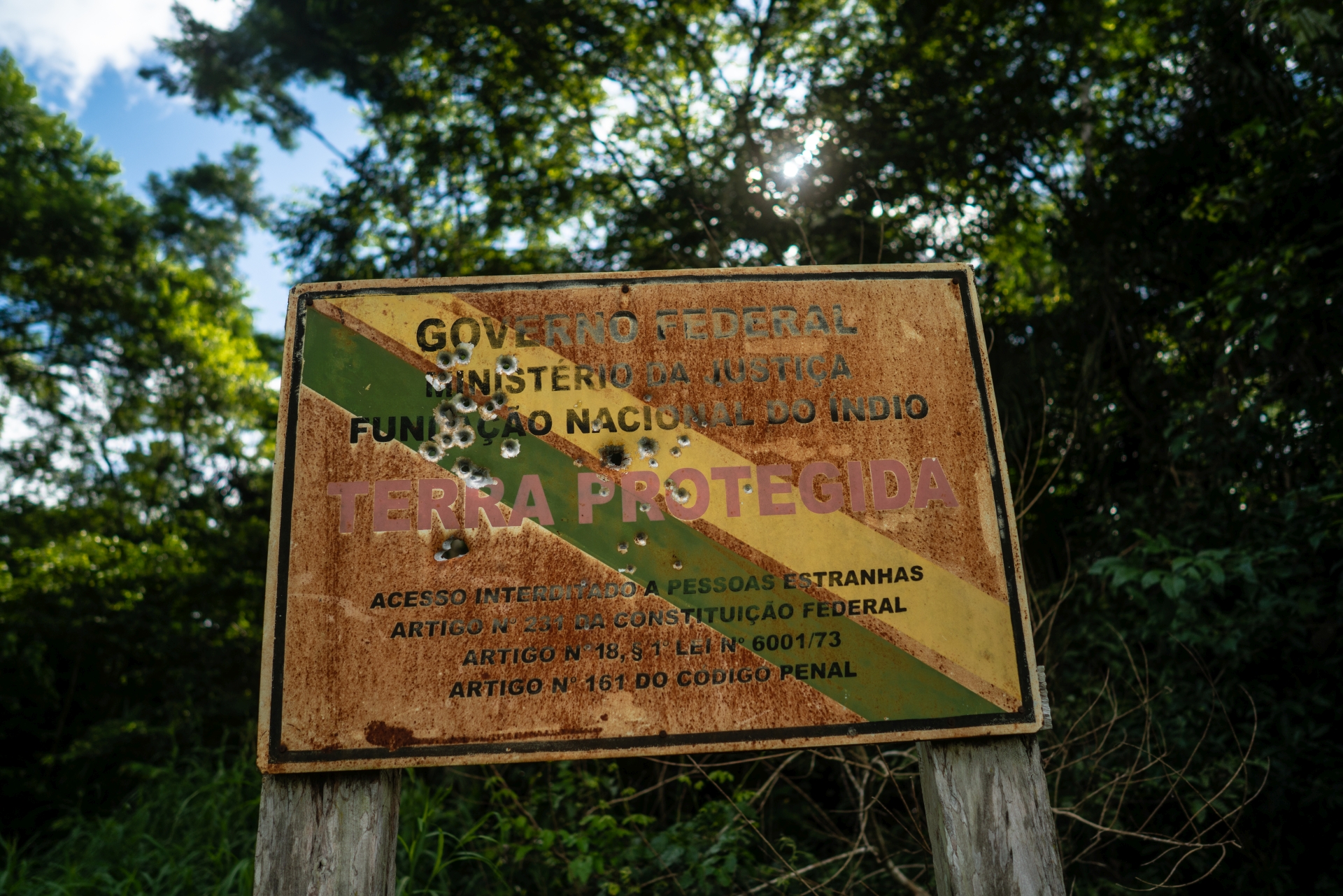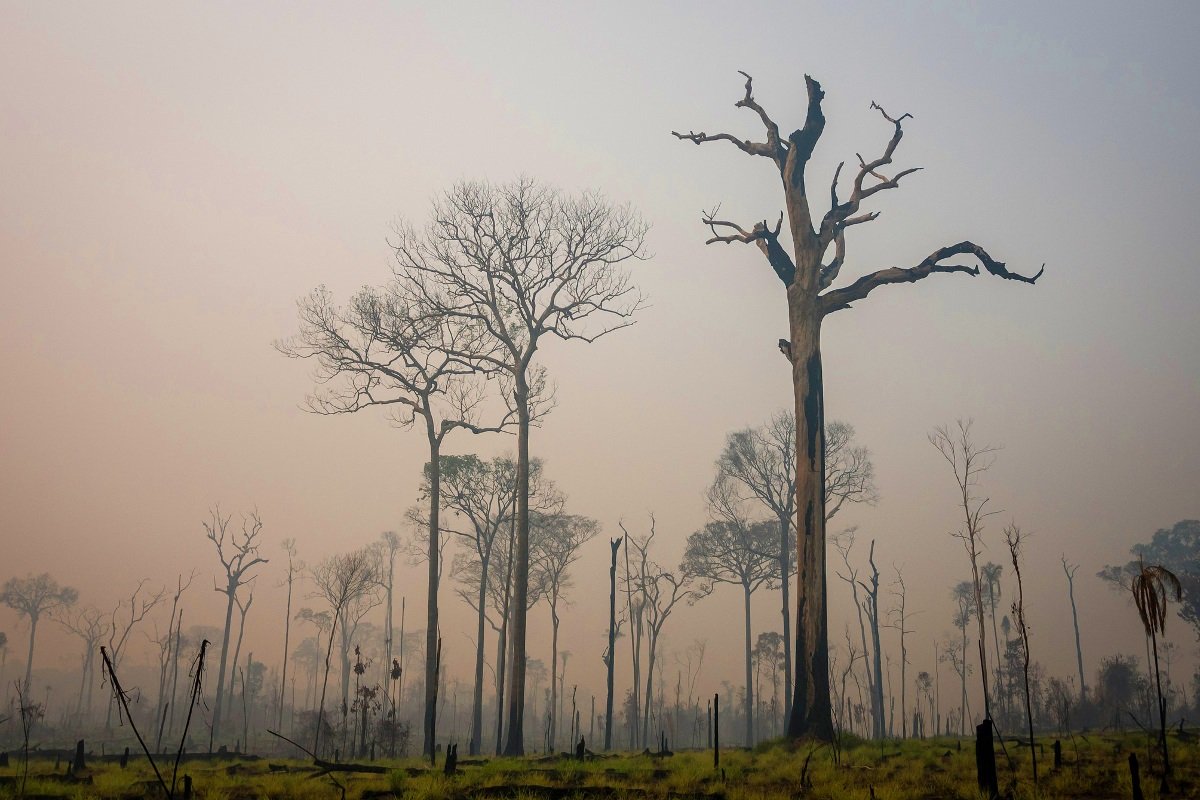The invasions of indigenous territories in Rondonia are not something new. But data on episodes of violence in the countryside, such as assassinations of leaders and threats to communities, reveal the resurgence of this fight.
By Gustavo Faleiros (text) and Fábio Nascimento (video and photos)
In Rondônia, the Indians are under siege. It is not just an expression. Open a map and try to locate the Brazilian state to the northeast of the border with Bolivia: decades of deforestation have left indigenous lands as the last green spots.
These lands are the source of the rivers that run through the state. These are the forests several ethnic groups, some of them reduced to a few hundred survivors, call home.
These lands are coveted today for their timber, their minerals, their “market value”. Within this besieged area not only is nature being decimated, but indigenous communities are increasingly cornered.
The invasion of their lands using fake documents (a practice called ‘grilagem’ in Brazil) and illegal logging are the crimes that are fostering this division of indigenous lands. The territories inhabited by the Karipuna and Uru-Eu-Wau-Wau peoples are being attacked from different directions.
As if we were watching a documentary about hordes of barbarians assaulting Rome, on a trip to Rondônia we witnessed constant invasions and threats to indigenous communities.
Imagine a game: the board is called Rondônia and the objective is to place all the pieces inside the last green islands of forest. The pieces are land grabbers and loggers. They move forward. In this task, they have the support of local politicians, as well as the House of Representatives and the Senate. Public officials and civil society try to prevent these invasions, but they are also threatened.
The Karipuna and Uru-Eu-Wau-Wau fight on. They have resisted for decades, but now it’s different. With the new president, Jair Bolsonaro, the war against indigenous territories has already been declared.
The dismayed chieftain
In September of last year, André disappeared. He was hunting in the jungle with his relatives when he decided to personally verify the presence of invaders inside the land of the Karipuna. He did not come back.
Already knowledgeable of the presence of loggers in their lands, they feared the worst: the chieftain had perhaps run into the invaders. As head of the village of Panorama, the only remaining Karipuna community, André had already suffered threats for his reports denouncing illegal logging and land grabbing within indigenous land.
For several days his cousins searched for him in the bushes bordering the Jaci Paraná River. They returned home that night without news. The chieftain’s mother, Katsiká, usually talkative and smiling, was heartbroken. Her other son, Adriano, also a leader among the Karipuna, had spoken at the United Nations headquarters in New York three months before about the imminent risk of an attack on their indigenous community.
At the end of the third afternoon, André was found. He was staggering along a riverbank after having walked through the jungle for 72 hours, without any food. It was a case of disorientation. The landscape of felled trees confused the chieftain, who was no longer able to find his way. Concerned by a face-to-face encounter with the loggers, he had made countless detours trying to get home.
When André received us in February in Panorama village, he recounted the episode without fanfare. For a 26-year-old man, the chieftain’s countenance is grave and rather unsmiling. The responsibility of being the head of the village seems to weigh on him.
“I no longer have inner peace,” he said. The threats started when he became chief, just a year ago. “I thought I’d give up, get out of here. However, I thought about my mom and my family.”
During our visit to the Karipuna’s territory, we went with André on a long walk to check if there were new deforestation spots inside their land. The eight-kilometer journey through the enclosed jungle gradually led us to a small clearing with tree markings signaling the abandoned campsites used by invaders.
We found coffee seedlings recently planted on the riverbank. The last time André had been there was September. We crossed the creek and began walking on a trail opened by the invaders. Only a few kilometers away, we overheard the intermittent sound of a machine. It sounded like a chainsaw. Tension set in. Unsure of how far away we were from the possible loggers, we began communicating by signs so as not to make any noise.
When we reached the end of the trail, we came across a sizeable deforested area. There was no visible sign of activity. However, the noise continued. As we got closer, we could tell it came from a truck or a tractor. It was a skid, a machine used to clear trees and open roads, the chieftain said.
That only confirmed what he already knew: the loggers were opening an additional road inside the indigenous ancestral land and were already in the center of the 152,000-hectare territory. The next day, on his way back to Panorama village, André told his mother, Katsiká, what he had seen. “Our land has never been so small,” she murmured.
The boy chieftain and the warrior uncle
Bahira will one day be the cacique, or village chief. No one knows when, but as a young prince, his future is certain: he has already been chosen to lead the village. Today his father Taroba is the chieftain.
Bahira is the youngest of four children. In the village of Upper Jamari, he lives with his father, grandmother, three sisters, uncles, aunts, cousins, and a nephew, Thallison, a one-year-old baby who affectionately clings to the adults’ legs.
Eleven-year-old Bahira is the person who fishes in the village. The white waters of the stream bordering their six wooden huts are full of slender piaba fish. He is also the designated shepherd for the six bulls owned by his community. Early each morning he milks their cows to bring milk to his family.
The future chieftain goes to the school located next to the village’s health center. He is the only child of his age there, although more children his age live in other small villages of the Uru-Eu-Wau-Wau Indians. But they are miles away.
The six existing Uru-Eu-Wau-Wau villages are spread out in a territory of 1.8 million hectares. There are also three villages inhabited by Amondawa Indians and three isolated or uncontacted indigenous groups.
Bahira’s closest friend seems to be his uncle Awapu. The 28-year-old likes to joke around and provoke the future chieftain. But his tone of voice changes when he talks about the threats. Awapu was alerted when he confiscated a motorbike from an invader inside their land.
One day, a neighboring owner told him: “It would be good if you stopped these things, they’re going to bring you problems”.
According to Bahira’s uncle, the advice they are usually given is to is “not to mess with the invaders and look for the police”. This is what they do. Several federal police officials have shared their WhatsApp numbers with indigenous leaders and they’re in touch.
However, there is a long way from a criminal complaint to effective action against the invaders. The Indians expect decisive actions, which take a long time to materialize. That’s why Awapu and other young leaders are often organizing rounds to patrol the areas historically coveted by the invaders.
In February 2017, along with his brother, chieftain Taroba, and other Uru-Eu-Wau-Wau Indians, Awapu surprised two men building a shack in a newly deforested area, a few kilometers from the village of Upper Jamari.
The Indians tied up the invaders and demanded information about who had sent them. In the video recorded that day, the two men claim that they were there in good faith, as they had been told that the “land plots” were documented and could be occupied.
In February, when we visited Upper Jamari, Awapu took us to the place where they found the invaders’ camp two years ago, in the northern part of the protected land. The Indians quickly noticed signs of a new entrance on the trail. In addition to branches that had been recently mowed down with a machete, there were plastic water bottles, beer cans and empty gallons of chainsaw oil.
The road followed a new path that approached the Floresta River, the same one that crosses the village. On the riverbank, they also saw traces of salt in a tapir feeding area: another sign of human presence, as this way they sought to attract this large mammal and other game.
Back in the village, Awapu told his family what he had seen. “They are going farther and farther,” he said after showing them photos of the newly cleared path on his cell phone.
Bahira, the future chieftain, accompanied the conversation to our side, quietly.
The Siege
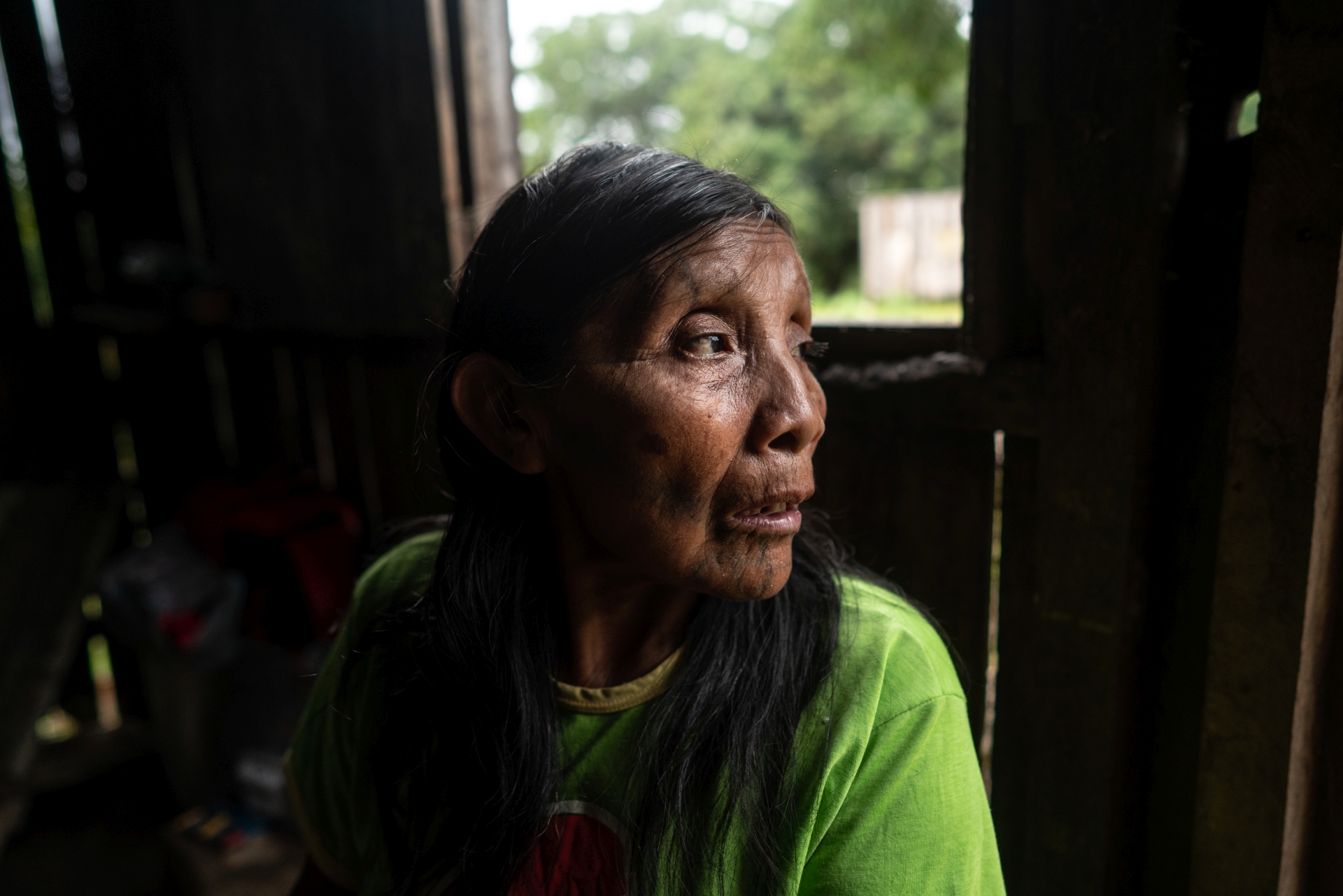
Invasions in indigenous territories in Rondônia are not new. The Karipuna and the Uru-Eu-Wau-Wau, who remained uncontacted until the 1970s, have lived ever since in a constant struggle to keep their land protected.
The legal status of both reservations continues to be questioned by outsiders, although they have been recognized and protected by presidential decrees. At the local level, rural landowners dispute the boundaries of the indigenous lands, arguing the existence of demarcation errors supposedly proven by old (or fake) documents. On a higher political sphere, mayors and even national Congressmembers defend proposed reductions of their territories. Both groups support each other with the discourse that there is “too much land for too few indigenous persons”.
Data from Catholic Church organizations that since the 1980s have monitored episodes of violence in the countryside, such as the assassination of leaders and threats to communities, reveals the intensification of this struggle.
According to the Indigenous Missionary Council (CIMI), since 2016 there have been eight episodes of invasion to steal wood and open new clearings within the Karipuna indigenous territory. In the case of the Uru-eu-wau-wau, since 2012 there have been four recorded attacks.
Another source of information, the Pastoral Land Commission (CPT), included threats made against Adriano Karipuna, André’s brother and a former chieftain, in its database. In 2017, Adriano received anonymous calls with death threats. In April of the following year, during the 17th session of the Permanent Forum on Indigenous Affairs at the UN headquarters in New York, he made an urgent plea:
“Our people were reduced to five persons. Today there are 58 of us in the land protected since 1998. However, loggers, miners, ranch owners and invaders encroach on us tirelessly. The Brazilian government is not protecting our territory.”
Evidence of this hostility against indigenous peoples also translates into deforestation. An analysis using data from the National Space Research Institute’s (Prodes-INPE) Satellite Tracking Programme points to increasing logging within and around ancestral lands. The latest available study (from August 2017 to July 2018) reveals that this was the period with the highest deforestation rate within the Karipuna and Uru-Eu-Wau-Wau lands in the last ten years – 460 hectares and 690 hectares respectively.
One hectare is approximately equivalent to a football pitch.
Expanding the analysis to a perimeter of 10 km around the territories, the phenomenon becomes more visible and shows where the pressure comes from. Since 2008, about 8400 hectares have been deforested around the Karipuna indigenous land and 3060 hectares around the Uru-Eu-Wau-Wau. In the last three years, the largest extensions of deforestation occurred within a 10 kilometers strip of land around both indigenous reservations: 1460 hectares were cleared in 2016, 1660 hectares in 2017, and 1430 hectares in 2018.
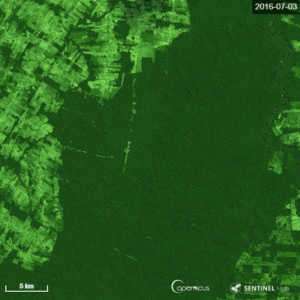
One recent example of the constant struggle over indigenous lands is the presence of overlapping properties on borders or even within the reservations. The Rural Environmental Registry (CAR) is the instrument created by the Brazilian government for land management after the approval of the new Forest Code in 2012. The size of properties in it is self-declared, as is the extension of permanent conservation areas.
Data collected by this registry shows that there are 325 declared rural properties within the Uru-Eu-Wau-Wau territory. Another 812 rural properties intersect partially with either indigenous territory.
In order to combat deforestation, Ibama (Brazil’s environmental agency) applies fines and initiates seizure proceedings against properties where environmental laws have been violated. Of 10,996 environmental legal cases opened in the state of Rondônia (as of November 15, 2018), 1073 are within 10 km of either of the reservations and 475 are within 3 km of them.
In the case of Uru-Eu-Wau-Wau, it is striking that of the 21 embargoed properties within their land, more than half of the sanctions (14) happened after 2015. One of the cases opened during this period -legal case number 6.944, dating May 16, 2017- exemplifies the type of environmental crime committed by invaders on indigenous lands.
The fine of R$ 414,000 reals (approx 100,000 US dollars) states that the reason behind it was the “damage of 68,342 hectares of native forests subject to special preservation, not available for authorization for exploitation or suppression, within the area of the Uru-Eu-Wau-Wau indigenous reservation, by way of timber exploitation.”
Explore the data: deforestation, roads, properties and mining areas overlapping with the Karipuna and Uru-Eu-Wau-Wau indigenous lands. Scroll to explore.
These facts show a pattern that appears over and over in the history of Rondônia: timber theft and illegal deforestation function as a land grabbing tactic. Once cleared of trees, the land’s value increases and is then divided and sold accordingly. Roundtables have been set up to solve these agrarian problems but, coincidentally, the invaders usually receive the support of local politicians and their representatives in national political circles in Brasilia.
In an interview in her office in the state capital of Porto Velho, attorney Gisele Bleggi of the Federal Public Prosecutor’s Office said there is evidence of groups systematically invading indigenous lands in Rondônia. Making a point of not revealing any names, she said several persons had been identified as having taken over property in areas belonging to the Indians. There are cases of groups of invaders who share the same lawyer.
“What we can say is that these are not humble people in search of land,” she stated.
The most recent episode of invasion of the indigenous Uru-Eu-Wau-Wau land occurred on January 12, 2019. In a video recorded by the inhabitants of the Linha 623 village, a group of men appears on a pathway opened within the eastern part of the indigenous reservation. At the entrance of this stretch of land, there is a metal plaque set up by the National Indian Foundation (Funai), the government agency responsible for indigenous affairs in Brazil. The signpost, marking the spot where protected lands begin, is full of bullet holes.
Juruna, one of the leaders of the ethnic group, confronts the invaders accompanied by only three other people from the village. “You cannot do this here, we are not going to allow it,” he says in the video recording, a bow and arrow in his hands. The outsider tells him that they are “seeking land” and asks him what solution can be found. After Juruna stresses once more that they cannot enter indigenous land, the slender, white-bearded threatens him. “Today we are here, but tomorrow you can expect more than 200 of us,” he says.
The leader Uru-Eu-Wau-Wau knows the man leading the group: he has been their neighbor fort at least three decades, living along the same Linha 623 road that runs through his settlement.
Sources mention that although invasions were frequent in the past, the big difference today is that neighbors of the indigenous lands now support the invaders.
That same January, a similar episode occurred on the Karipuna indigenous land. On the 20th, two inhabitants of Panorama village were traveling for a federal government health check, when 20 people entered the protected territory in an area known as Piquiá, which is located only 8 kilometers from the village. The invaders had occupied a FUNAI guard post and refused to leave the territory. Since then the Indians have stopped using the road that gives access to the Karipuna land.
Both indigenous people and their advocates in NGOs and state agencies for the protection of indigenous people have identified growing threats to their territories as a result of the hostile discourse of Brazil’s new president, Jair Bolsonaro. During the election campaign, one of his promises was the interruption of existing demarcation procedures of new indigenous lands, in addition to revisions of existing ones. After taking office, Bolsonaro and his government have been announcing measures that further weaken FUNAI, transferring the demarcation of indigenous lands from the Ministry of Justice to the Ministry of Agriculture.
The promising Rondônia
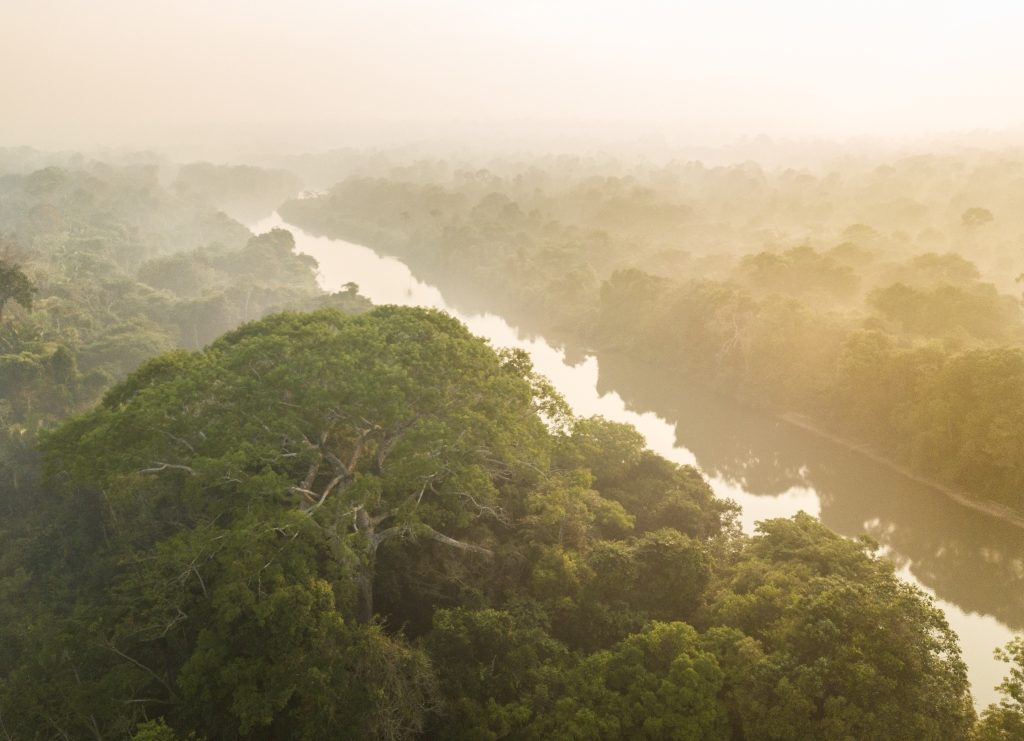
Marshal Cândido Rondon (1865-1958) probably never imagined that a century after his expeditions to the jungles of the Guaporé, Mamoré, and Madeira rivers, the land that today bears his name would be transformed into an economic experiment with traces of genocide.
Being himself a descendant of Indians, he became the creator of the Indigenous Protection Service (SPI) in 1910, which years later would give way to the current Brazilian government institution for indigenous affairs, FUNAI. After expeditions at the end of the 19th century to build telegraph lines and explore the Brazilian territories bordering Bolivia, the soldier settled down in the Brazilian far west in an attempt to contact isolated tribes.
Today, Rondônia is the only Brazilian state that pays tribute to a historic figure. The territory of the “Brave Indians,” however, quickly became the “gateway to the Amazon” when the government of Juscelino Kubitschek began construction of the BR-364 road in the 1960s. Rondon’s telegraph lines outlined the path that would follow the opening of the road. This highway was the central axis of the occupation of the western Brazilian Amazon during the 1970s, when the resettlement of rural areas was promoted by the newly installed military government and by its new agency in charge of distributing land, the INCRA (National Institute of Settling and Agrarian Reform).
The arrival of settlers meant the first contacts with diverse ethnic groups, including many indigenous peoples of the “Central Tupi” or Kawahib family, like the Piripkura, the Karipuna, and the Uru-eu-wau-wau. Today, these ethnic groups have one thing in common: they have been reduced to a few dozen people. The Uru-eu-wau-wau, also known as Jupaú or “black mouths”, number about 85 Indians. The Karipuna, who were once known as black mouths for using the same Jenipapo tattoos around the lips, suffered even more. Currently, only 58 Indians inhabit a single village on the Jaci Paraná River.
The Kawahib (or Cauaibe) groups occupied the Madeira River basin and its tributaries in the 19th century and unknowingly began protecting lands of great environmental importance. They are in a transition area between the Amazon and the Cerrado, where dense vegetation gives way to grasslands and shrubs. However, its most important environmental feature is the mountainous relief that gives birth to the headwaters of all the vital rivers in the state of Rondônia, including the largest tributaries of the Madeira, Guaporé and Mármore sub-basins that feed the Amazon River.
The anthropologists and explorers who participated in these initial contacts in the 1970s knew of the existence of a cycle of attacks and counter attacks between the Indians and rubber tappers.
Therefore, when the arrival of the settlers began, they requested, in 1974, through FUNAI the protection of the areas in western Rondônia where the Uru-Eu-Wau-Wau and the Karipuna roamed.
But the cycle of occupation of the Amazon promoted by the military and the settling of agricultural lands advanced at full steam. Today, of Rondônia’s 52 municipalities, 48 arose from agrarian settlements.
The homologation of indigenous territories only occurred in the 1990s, through decrees signed by President Fernando Collor de Melo, in in 1991 in the case of the Uru-Eu-Wau-Wau, and his successor Fernando Henrique Cardoso in 1998 in the case of the Karipuna. In the 20-year interval between the protection request and the effective demarcation of the territories, the struggle between settlers and indigenous peoples over land had already deepened. And continues to this day.
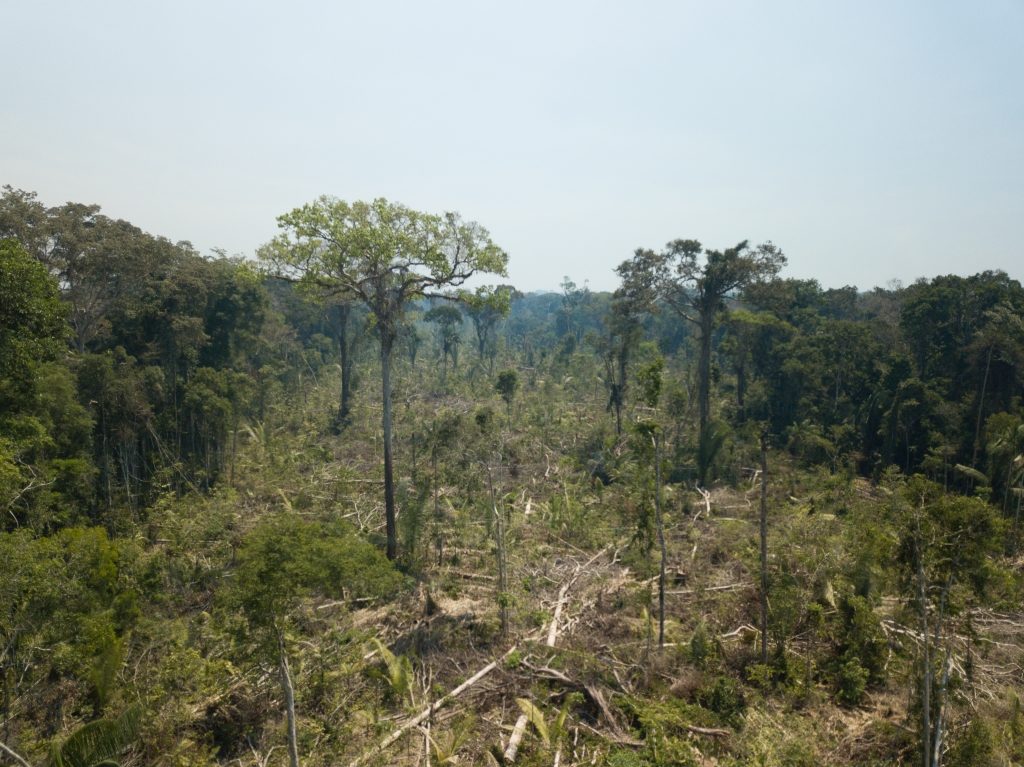
“After 47 years (of the creation of agricultural settlements) we are experiencing problems that could have been solved, and the issue kept on being postponed because these were indigenous lands,” said Cletho Muniz Britto, a former INCRA superintendent in Rondônia, criticizing FUNAI in a public hearing on March 27, 2018 held by the Agriculture Committee of the Federal Senate. The session was convened by the former state governor, Senator Ivo Cassol, to debate the conflictive agrarian situation between the settlers and the Uru-Eu-Wau-Wau Indians.
INCRA’s understanding is that the government wrongly demarcated indigenous land in an area that had been decreed as an agrarian reform settlement. In 1975 a decree expropriated thousands of hectares belonging to eight existing rubber estates in the area, totalling 533,900 hectares. Part of this territory was destined to the Burareiro Directed Settlement Project (PAD) for small farm-owners, where 1,500 families settled.
However, FUNAI, supporting the requests of its anthropologists and explorers who had witnessed the death of many indigenous people from disease and conflict, decided to create the land in 1978, three years after INCRA’s settlements had established. However, the agency’s documents prove that an interdiction of settlements in the area had already been decreed in 1974, before INCRA had created Burareiro.
Thus, 105 families were affected by the overlap with indigenous land. Litigation around this area opened an invasion front. INCRA, in disagreement with FUNAI, continued to issue land titles within the indigenous reservation. A comparison of the data of the old plots of land created via requests before the Rural Environmental Registry and the current deforestation to the north of the Uru-eu-wau-wau indigenous land shows the polygons are practically the same.
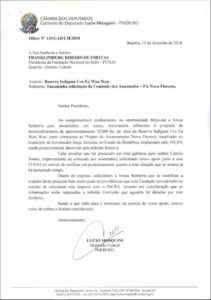
In the session led by Senator Ivo Cassol in March 2018 in Congress, lawyer Ermogenes Jacinto de Souza, representative of settlers in the municipality of Jorge Teixeira, presented a request for the extraction of an area of 52,000 hectares within the indigenous territory. “If you count more or less 600 Indians, or even assume there are 1,000 Indians in 2 million hectares, you would have 2,000 hectares per Indian”, he said as he argued in favor of a reduction of their territory.
This same request seems to have been supported a month earlier by federal deputy Lúcio Mosquini of the MDB party of Rondônia, through a letter sent by his office to the president of FUNAI on February 15, 2018. In the document, the Congressman inquired about the indigenous affairs agency’s position on the possibility of reducing 52,600,000 hectares of the Uru-eu-wau-wau land. A month later at the public hearing, he defended his point of view. “FUNAI should be flexible about the anthropized area (on indigenous land),” he said.
When we were in Rondônia, in the city of Jaru, in the Mosquini’s electoral district, we asked his advisors for an interview with the deputy. They said he couldn’t meet us. However, his parliamentary advisor Sigmar Rodrigues Nunes said in a telephone conversation that there is no legislative proposal for the reduction of the indigenous reservation.
In Congress, senators complained to FUNAI President, General Franklimberg Ribeiro de Freitas, about the agency’s delay in solving conflicts with settlers. Even under former President Michel Temer, the general stated that the authority would be unable to review boundaries established by a presidential decree. According to the Constitution, indigenous lands decreed by the president can only be reviewed through a bill approved by the National Congress.
Jair Bolsonaro recently reappointed Freitas at the helm of FUNAI.
On the front line
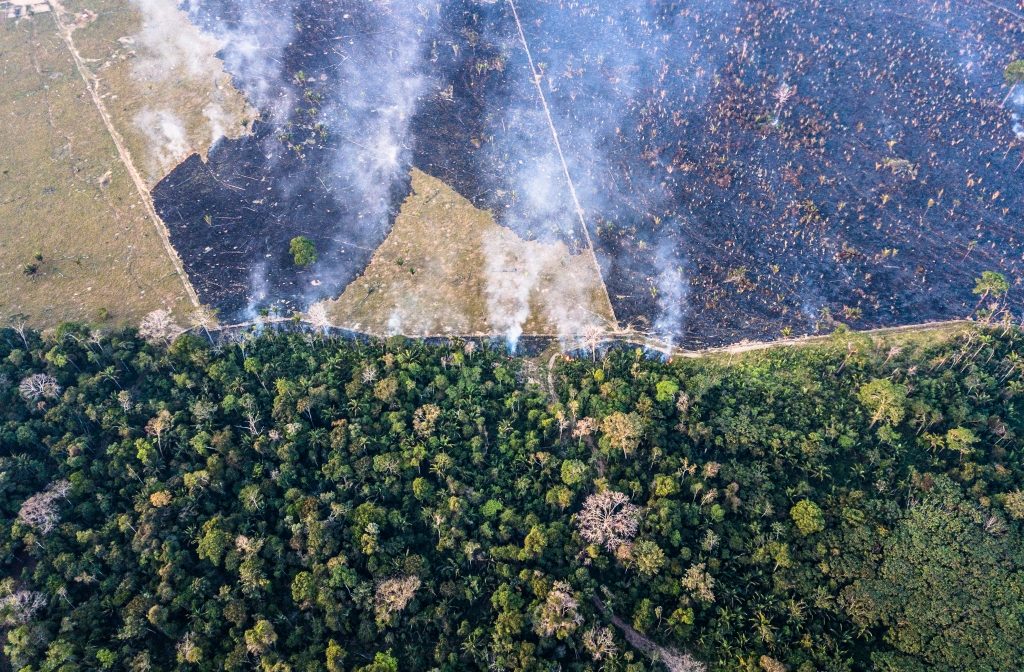
After 35 years living in Rondônia, friar Volmir Bavaresco still holds on to his gaucho accent from southern Brazil. Unaccustomed to chitchat, the Dominican monk with a bushy beard and long gray hair is the regional coordinator of the Indigenous Missionary Council (CIMI) in Rondônia. After years of working on other fronts, he took upon the defense of the Karipuna lands. Since 2016, he has been coordinating actions with the indigenous people of this ethnic group.
“Our perception is that, if the Karipuna fall, all the protection of indigenous lands in Rondônia falls and who knows if in Brazil,” he warned.
CIMI, an organization of the Catholic Church founded in 1972, has been since its birth on the front line of monitoring conflicts with indigenous people that have occurred as a result of the arrival of settlers in the Amazon.
In addition to the Catholic organization, Greenpeace is also helping the indigenous people. Through a project called “All Eyes on the Amazon” it is monitoring new deforestation hotspots on indigenous lands using overflights and satellite images.
The initiative to ask CIMI and Greenpeace for help came from the indigenous people themselves. According to chieftain André, the request arose at a moment when they, the Karipuna, felt more isolated, even without the support of FUNAI. In the perception of the Karipuna leader, in recent years the federal agency abandoned them. Over the past five years, FUNAI’s budget decreased from R$757 million (USD 200 million) to R$597 million (USD 157 million).
Although the threats faced by the Karipuna are different to those affecting the Uru-eu-wau-wau, conflicts with settlers are also at the root of their problems. Invasions over the years have been caused by the extraction of wood and, consequently, by the opening of illegal roads within their territory.
The destruction is concentrated in the western part of the indigenous land, in the district of União Bandeirantes. Originally an area dedicated to sustainable timber extraction, União Bandeirantes had 10 licensed sawmills at the beginning of its occupation, in the early 2000s. However, illegal exploitation ended up prevailing. Wood extracted from the Karipuna land is used today to supply nearby sawmills.
The content of sustainable management plans issued by the government of the state of Rondônia are not available publicly. When we contacted them, the state’s Secretariat of Environmental Development (SEDAM) stated information on these authorizations could not be sent.
The Federal Public Prosecutor’s Office, however, requested an audit of the currently valid management plans around the Karipuna indigenous land in a July 2018 Public Civil Action. At the time of publishing this story, not even the prosecutors had received data on União Bandeirantes’ sustainable management plans.
Another concern is the emergence of lawsuits over the Karipuna land. It is possible to find a series of videos on the Internet in which Ediney Holanda da Silva, the representative of engineering company Amazon Gel, meets with rural landowners of União Bandeirantes and discusses procedures on how to obtain documents and land possession within indigenous lands.
According to him, this is “something big” that has powerful people behind it. “People who criticize us don’t know that the authorities are on our side,” he says, before alerting his audience that Bandeirante’s Whatsapp groups should be more discreet. “I see a man posting a photo of a trunk of wood, and the man doesn’t even know the Federal Police are monitoring him,” he adds. (Watch the video here.)
Despite participating in meetings as the company’s main representative, Ediney is not listed as a partner. A search of the Amazon Gel registry in the Rondônia Treasury reveals that the company with tax number 26.244.487/0001-41 operates with only one partner, an individual microentrepreneur by the name of Cristiane Gomes da Silva.
The company is authorized to perform civil engineering services, but there is no authorization in the registry of Amazon Gel to conduct services of topography, land measurement and georeferencing by satellites. Generally, these are the skills required for land regularization.
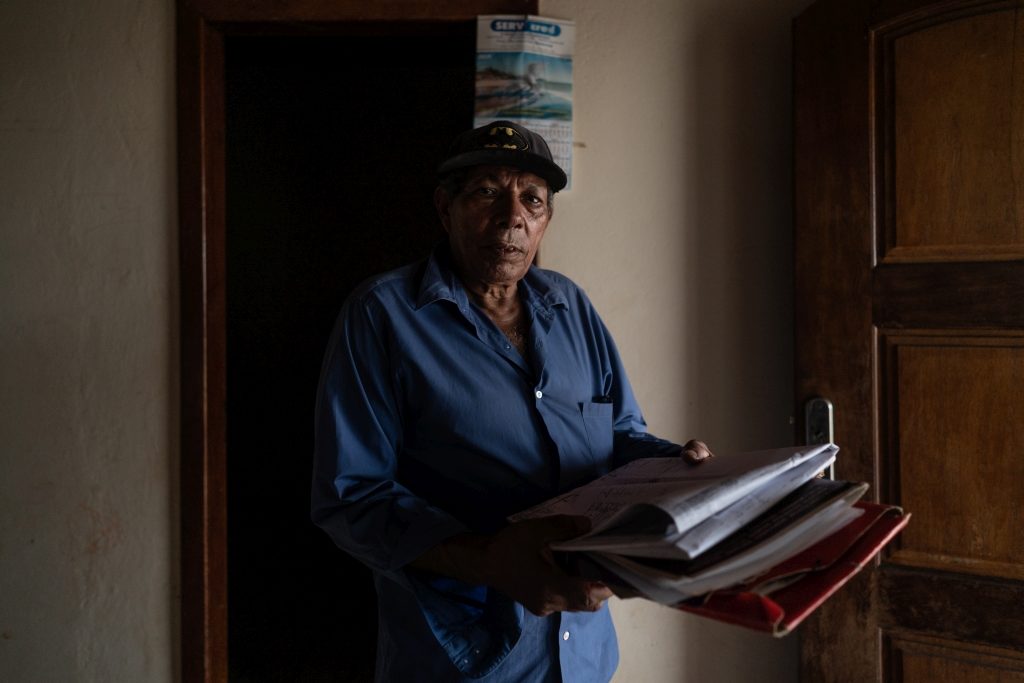
The sale or intermediation of lands within indigenous territories is a common activity in Rondônia. In Ariquemes, the second largest city in the state, we encountered Nelson Bispo dos Santos. Born in Bahia and raised in Minas Gerais, he has lived in the land of Rondon for three decades. In 2017, he and 19 people more were imprisoned as a result of the Federal Police’s Operation Jurerei, which investigated the sale of plots within the Uru-eu-wau-wau indigenous land.
According to the criminal complaint, Santos was encouraging the invasion of protected land through the Association of Rural Producers of the Curupira Community. One of the pieces of evidence was found in 2017 in the cell phone of one of the invaders who had been apprehended by the indigenous people within the reservation. In January, in a video filmed by himself, Santos urges rural landowners to “take over and take care of their plots of land”.
In wait of a ruling in his case, Santos lives under house arrest in a residential neighborhood in Ariquemes, forced to wear an electronic ankle monitor. On the afternoon of February 22nd, he received us for an interview and showed us the documents that justify, in his opinion, the right to own land within the indigenous territory. One of them is precisely a document from the Rural Environmental Register (CAR), in which he self-declared 4000 hectares of land within the territory of the Uru-eu-wau-wau indians.
According to information from the Federal Police, the assigning of plots of land was the modus operandi of a gang that cornered the Indians. Land sales are a front for deforestation. The criminal investigation established that land was being sold at 1,500 to 2,000 reais (550 dollars) per alqueire (a measure of land common in Brazil that roughly equals 1,2 hectares), a tiny fragment of the value of land in the region. The price there is at least 20 times higher – from 20,000 to 40,000 reais.
One person who does not believe their discourse of land ownership is João Alberto Ribeiro, 61, current head of the Pacaás Novos National Park, an area of 765,000 hectares that overlaps with the indigenous territory. In his routine inspections – which take place every 15 days – the national park manager has already maps detailing land divisions on three separate occasions, totalling 60,000 hectares within the indigenous land. “That’s a professional’s work,” he said.
For Ribeiro, there is a cautionary tale for Rondônia in the Bom Futuro (or Good Future) National Forest. This protected area that formerly covered 280,000 hectares and suffered concerted attacks by loggers ended up having only 97,300 hectares. State agency Ibama failed to have a proper monitoring system in place. Settlements and even sawmills were set up inside the reservation. In 2008, at the time of Ivo Cassol’s local government, a negotiation between the state and federal parliaments approved the reduction of the protected area, therefore giving solid ground to those who defend the thesis that illegal occupation of land can in fact lead to its legal ownership.
“The dominoes fall one after another,” Ribeiro says, referring to the constant invasions of protected areas and indigenous lands in the state. Like friar Volmir Bavaresco and prosecutor Gisele Bleggi, he believes that there is a concerted action aiming at land grabbing in Rondônia’s protected areas.
A common trait found in all the allies of the Indians or public officials in charge of defending them with whom we talked is that they also feel threatened. João Alberto recounts cinema-like episodes in which he escaped ambushes organized by illegal loggers. The situation has reached such a point that inspectors of the Chico Mendes Institute for Biodiversity Conservation (ICMBio), Brazil’s biodiversity research institute, can no longer use the inspection post near the park. “There are various threats, both general and specific. People learn about them through third parties,” he said.
Ivaneide Bandeira, founder of the NGO Kanindé, which has worked on indigenous and environmental issues in Rondônia for two decades, says she does not doubt that the situation has deteriorated after Bolsonaro’s rise to power. Invaders now feel “empowered”, she says.
She defines the situation as extremely fragile. On the same day in which we interviewed her, she had met a group of indigenous people who had warned her not to wear a football shirt with the Kanindé logo on it. “We are targets today,” she lamented.
With her hands on a map showing the limits of the Uru-eu-wau-wau territory, Neidinha (as she is known) explains that the advance on both sides of the protected land is “problematic”, because right in the center of the indigenous land there are three uncontacted groups. “It is a rich land that many people wanting to be done with,” she says.
If conflicts over indigenous lands have been constant since the initial days of Rondonia’s settlement, what would be the difference with the new government of Bolsonaro? we ask. “The big difference today is that the invasion is happening right beside the villages,” she says.
A few days before the closing of this report, we received information from Neidinha´s NGO, Kanindé, about new invasions that occurred during March and early April. That is, shortly after our visit. This time, the entrances took place on Linha C5 near the village of Alto Jamari, north of the indigenous land. This the village where Bahira and his uncle, Awapu, live.
In a video posted on April 2, the squatters themselves speak of 400 families living in the indigenous land. Two days later, environmental and military police officers took emergency action with overflights and searches in the area. They found the shed of an association still unknown in previous invasions. So far, the invaders have not been withdrawn and there has been no action by the federal government.
This report received support from the Rainforest Journalism Fund and the Pulitzer Center on Crisis Reporting.
Additional thanks to Kanindé and Greenpeace-Brasil for their logistical support.


